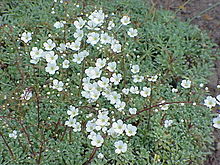
Back كاسر الحجر Arabic كاسر الحجر ARZ Daşdələn Azerbaijani داش دلن AZB Каменяломнік Byelorussian Каменоломка Bulgarian Saxífraga Catalan Saxifraga CEB Lomikámen Czech Stenbræk Danish
| Saxifraga | |
|---|---|

| |
| Saxifraga cochlearis | |
| Scientific classification | |
| Kingdom: | Plantae |
| Clade: | Tracheophytes |
| Clade: | Angiosperms |
| Clade: | Eudicots |
| Order: | Saxifragales |
| Family: | Saxifragaceae |
| Genus: | Saxifraga Tourn. ex L. (1753) |
| Type species | |
| Saxifraga granulata | |
| Sections | |
|
See text | |
| Synonyms[1] | |
|
Synonyms
| |
Saxifraga is the largest genus in the family Saxifragaceae, containing about 473 species of holarctic perennial plants, known as saxifrages[1][2] or rockfoils.[3] The Latin word saxifraga means literally "stone-breaker", from Latin saxum ("rock" or "stone") + frangere ("to break"). It is usually thought to indicate a medicinal use for treatment of urinary calculi (known as kidney or bladder stones), rather than breaking rocks apart.[2][4]
- ^ a b "Saxifraga Tourn. ex L." Plants of the World Online. Royal Botanic Gardens, Kew. Retrieved 13 April 2024.
- ^ a b "Saxifraga". National Plant Collections. Cambridge University Botanic Garden. Retrieved October 3, 2011.
- ^ Roger Spencer, ed. Horticultural Flora of South-Eastern Australia. UNSW Press, 2002. p. 81. ISBN 9780868401676
- ^ D. A. Webb & R. J. Gornall (1989). Saxifrages of Europe. Christopher Helm. p. 19. ISBN 0-7470-3407-9.